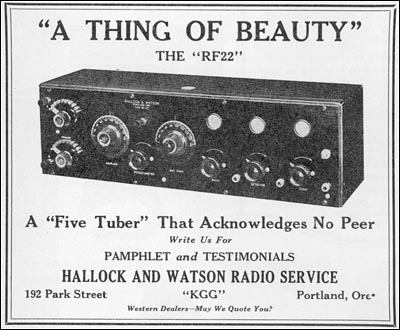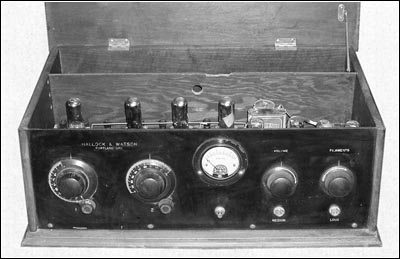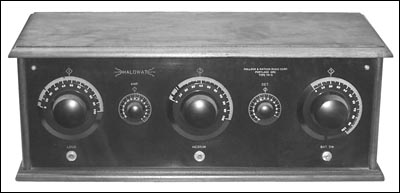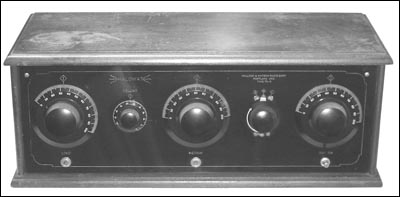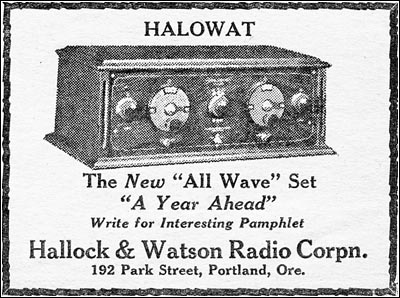Of Old Radios And Related Items--Published Monthly
Hallock and Watson
BY ART REDMAN
Web Edition
The 1920s saw the formation of many radio manufacturing companies. Art Redman pursues his interest in Pacific Northwest radio manufacturers in this article on the Hallock and Watson Radio Corporation and its "Halowat" line of radios. (Editor)
Halowat was the trademark of the radio firm of Hallock and Watson commencing in 1924. The "wat" part of the trademark was Clifton H. Watson, born in 1892, who got his start in radio at the public library in Portland, Oregon, where a wireless club had been formed in 1907. The only other source of information about radio at the time was through magazines. At the library, Watson obtained plans to build a magnetic coherer detector, which allowed him to receive signals across the room from his spark coil transmitter. Because he sported a red moustache, he became known to some `as "the cat's whisker."
When the USS Connecticut, the flagship of the Great White Fleet, came to the West Coast in 1908, Watson was able to go aboard. The sight of a Slaby-Arco 2-kilowatt spark transmitter provided him with enough information to construct a larger 1-inch spark gap transmitter. He helped install the Deforest transmitter at Station PE, the United Wireless Station, located at the 1,072-foot summit of Council Crest in Portland's west hills. He was able to contact that station and occasional ships coming up the Columbia River using the call sign "W." A 3-slide tuner and carborundum detector comprised the receiving end of the station.
Figure 3. The Hallock and Watson RF22 as advertised in the March 1924 issue of "Radio."College Years
During the fall of 1910, Watson, along with Joseph Homer Hallock, (See Figure 1 in print version), the "Halo" half of Halowat, enrolled at the Oregon Agricultural College at Corvallis, now Oregon State University. The two students shipped a Ham radio station to the fraternity house, later installing the antenna between the roof of the administration building and the chimney of the heating plant. The station was powerful enough to work PH in San Francisco, NPL Point Loma, and PA in Seattle.
On the night of June 28, 1911, Watson handled the distress calls of the steamer SS Spokane which was sinking in the Gulf of Alaska. He directed some of the rescue work and received $25 as his share of the salvage money. After college, Watson worked as an operator on Alaskan coastal steamers.
Early Career Years
In 1915, Watson and Hallock installed five transmitters for the Montana Power Company. In 1916, they built a radio system comprising a stationary gap and later a rotary gap for the Northwestern Electric Company as a link from their Portland office to their generating plant near White Salmon, Washington. The company claimed this was the first time a utility had used a wireless for load dispatching anywhere in the country.
Figure 4. This Hallock and Watson 8-tube superhet used Type UV-199 tubes and a meter to monitor filament voltage.At this time, the pair separated, and Watson was appointed Radio Inspector at Seattle, Washington during World War I. After the war, he was put in charge of the Wireless Laboratory at the Mare Island, California, Naval Yard.
During World War I, Joseph Hallock was in charge of the powerful Navy arc station at Bordeaux, France. After the war, Hallock worked for Federal Telegraph and supervised the installation of two wireless transmitters for the Republic of China.
They joined together in business again in 1921 as the Hallock and Watson Radio Service, and started broadcasting first as Station 7XI, and later, in 1922, as KGG on 360 meters. This early 5-watt station operation was an Esso motor-generator transmitter with a flat-top antenna above the building.
Beginning in early 1922, Watson wrote an Oregon Journal newspaper radio column as "C.H. Watson, Radio Engineer." Interest in radio became apparent that year after the first three broadcasting stations had gone on the air in Portland.
The Manufacturing Years
The next step for Hallock and Watson was the manufacture of radio sets, beginning in 1923 with the Models RF12 and RF22, which sold for $100 and $125 respectively. Figures 2 (see print version) and 3 show early advertisements promoting these sets. The company was incorporated with Hallock as president and Clifton Watson as treasurer at 190-192 Park Street (now the 900 block of SW Park Avenue at the southeast corner of SW Taylor Street). This downtown Portland spot was also their salesroom until 1931.
Figure 6. A front view of the 1925 "Halowat" Model TR-5, a TRF 3-dialer, which used five Type 01-A tubes.The manufacturing plant was located at 406 East Alder Street across the river from downtown. The firm soon produced two superhet receivers -- a Porta-pak 8 model containing a 5-volt panel meter, of which 577 were manufactured, and the 8-tube set, shown in Figures 4 and 5 (see print version).
Manufacturing superhets made Hallock and Watson subject to future litigation from RCA. In fact, attorneys from RCA visited Hallock at his Portland plant and strongly suggested that if he did not stop making superheterodynes, the firm of Hallock and Watson would face a lawsuit for patent infringement.
The TRFs
The company appears to have made a wise decision and switched to manufacturing TRF sets. The two Type TR-5s, made in 1925 and 1926, were the first models to bear the "Halowat" label. A distinctive logo was designed displaying three small lightning bolts at each end of the Halowat name. The Model TR-5 sold for $90 and incorporated the tuned radio frequency circuit. Views of the TR-5 are shown in Figures 6 through 9 (see print version).
The two audio transformers in the TR-5 models are the Hedgehog brand, a unique, small, all wire-wound type, having a 1:3 ratio. It was a product of the Premier Electric Company of Chicago. The transformers are mounted underneath the sub-panel and are known today for their high failure rate. The two phone jacks (loud and medium volume output) are from the Federal Telephone and Telegraph Company of Buffalo, New York. The fixed capacitors are a 0.00025 mF grid leak bypass capacitor and two 0.001 mF capacitors made by the New York Coil Company. The Daven Radio Company made the 3.0 megohm grid leak resistor, and all the parts were connected by square wire bus bar wiring.
The TR-5 models had three vertically mounted Coto Company coils wound with green silk wire in a pancake shape. One rheostat controlled the filament voltage to the detector stage and thereby volume. The set was housed in an 81/2" wide x 22" long x 81/2" high cabinet. An advertisement for the Model TR-5 appears in Figure 10 (see print version).
There are several differences between the two models. The 1925 model uses five Type UX-01-A tubes and an additional rheostat that controls filament voltage to the first RF stage. The 1926 model uses four Type 01-A tubes and a Type UX-112 tube in the final amplifier stage. It has a new 3-tap wavelength selector switch mounted on the front panel.
The 1925 model's three variable 250 mmf capacitors were made by the General Radio Company and used counterweights; the 1926 model's tuning capacitors were the Premier Company's Crowfoot brand, low-loss type. The 1925 model came with an instruction pamphlet, while the 1926 model had an instruction card and a station card list attached under the cabinet lid.
Figure 8. The 1926 version of the Model TR-5 uses four Type 01-A tubes and one Type UX-112.Later 1926 TR-5s used a brown, instead of black Bakelite front panel with Kurz-Kasch knobs and an engraved border line around the perimeter of the front panel. It had no front phone jacks, and the on/off switch was moved to the lower center of the panel.
The All Wave Type AW-5
The Halowat All Wave Type AW-5 receiver sold for $155 in 1926 and was the firm's best and last radio. It was advertised as being "unmatched for tone" and available in several cabinets, all with 2-dial control with direct reading of wave lengths in the dials, covering the range from 185 to 570 meters with equal efficiency. Advertisements for the All Wave sets are shown in Figures 11 and 12 (see print version).
This set was "designed to use the new power tubes in audio -- the amplifier stage (71As) and ultra-modern audio transformers, (large General Type 285 having a 2:1 ratio)." It was touted as having "the most advanced and proven hookup to account for the wide range and marvelous tone in Halowat."
The AW-5 Type A cabinet was 91/4" high x 10" wide x 22" long, while the AW-5 longer style had two side battery compartments in a self contained cabinet measuring 10" wide x 111/2" high x 36" long.
The longer cabinet model also had a 3-way selector switch (short, medium and long wave) identical to one in the 1926 TR-5 model with a 1-gang variable capacitor directly behind it. The Type A did not have a tap switch and used a double ganged tuning capacitor and one single gang type. The long model also had two tuning dials and an additional three single-gang tuning capacitor inside.
Figure 11. An "All Wave " set advertisement in the "Portland Telegram," February 27,1926.Both models had an off/on toggle switch and two smaller controls for "Soft/Loud" under the left tuner and "Short/Long" under the right tuner. The Type A had one volume control marked "Volume." The long style AW-5 had two rheostats for volume control labeled "Audio" and "Radio." The company continued production of the TR-5 as a lower cost model after the AW-5 was introduced, although by 1927, 3-dial battery sets were obsolete.
Radio Broadcast Stations
The firm moved into the Wilhelm Building at 355 Everett Street (now NW Fifth Avenue and NW Everett) in late 1926. Later 1926 TR-5 models showed this address, but soon Hallock and Watson abandoned the radio manufacturing business and moved to 494 NE 12th Avenue in 1928 to continue radio repairing and retailing. The firm became known in this period for the design and building of over ten radio broadcast stations, including KOIN in the Pacific Northwest.
The most notable was the fulfillment of Watson's dream of a police radio communication system, which he first proposed in 1921 to the Portland Chief of Police. The dream became a reality in April 1932 when the firm of Hallock and Watson built the 50-watt transmitter and later a more powerful 500-watt system for police station KGPP. Watson said that "Portland actually had in operation the first 'Police Radio' in the world, although at the time it was not municipally owned."
This claim is confusing. The first "Police Radio" actually refers to an earlier 5-watt experimental station built by Charles Austin of the Northwestern Radio Manufacturing Company. Watson also mentions in his address to the Portland City Council that he traveled to Los Angeles in 1931 at his own expense and that "many of the ideas and plans that have been proven efficient in Los Angeles were utilized by me in organizing and planning our own communication system."
Cliff Watson operated Amateur Radio Station W7ANO and worked as radio engineer for the Portland Police Department until World War II when he went on active duty with the US Navy. After the war, he was appointed radio engineer at the Electronic Laboratory of Naval Radio at San Diego. He died in San Diego, California, in 1973 at the age of 81.
"We made a lot of money in the 11 years we were in business," said Watson's partner, Joseph Hallock in a newspaper interview, "but the Depression wiped us out."
During the 1930s, Hallock was an announcer and actor for several radio stations appearing live on dramatic programs. He went to work for the FCC in 1935 and stayed for 25 years, becoming head of the Portland office in 1952. He died at Lake Oswego, Oregon, in 1976 at the age of 85.
Photo Credits: Sonny Clutter
(Art Redman, 77331 SE 44th Ave., Portland, OR 97206)
Art Redman is a charter member of the Northwest Vintage Radio Society, which was founded in 1974. He is a frequent contributor to the Society's newsletter "The Call Letter." His current interest is doing research on Pacific Northwest radio manufacturers.
Bibliography
"A Thing of Beauty," Adv., Radio, March 1924, p. 50.
Bowers, Howard. "Wireless Ops of Old." Radio Electronics News, February, 1954, pp.186-187.
"Halowat All-Wave Type AW-5," Adv., The 1926 Pacific Northwest Radio Exposition Program, p. 15.
Howard, Richard. Member of Northwest Vintage Radio Society. Owner and provider of information on two Hallock and Watson Model AW-5 radios, Porta-pak No. 577, one unnumbered superheterodyne, and a Model TR-5 No. 394.
"Joseph Hallock," Obituary. The Oregon Journal, September 20, 1976, p. 8.
Marriner, Edward H. "Amateur Wireless before 1912 in the Pacific Northwest." West Coast Ham Ads, March, 1957. pp. 11, 18.
Parker, Michael, Member of Northwest Vintage Radio Society. Owner and provider of information on three Hallock & Watson radios: 1925 TR-5 model radio.
"Portland Radio Pioneer Dies," The Oregonian, September 19, 1976, p. H10.
Sloat, F.W. "The Hallock and Watson Story." The Call Letter: Northwest Vintage Radio Society, November, 1997, pp. 5-7.
Watson, Clifton. "Address to the City of Portland, Oregon City Council," June, 1934.
| [Free Sample] [Books, etc., For Sale] [Subscribe to A.R.C./Renew] [Classified Ads] [Auction Prices] [Event Calendar] [Links] [Home] [Issue Archives] [Book Reviews] [Subscription Information] [A.R.C. FAQ] URL = http://www.antiqueradio.com/Jun06_Redman_HallockWatson.html Copyright © 1996-2006 by John V. Terrey - For personal use only. Last revised: June 1, 2006. For Customer Assistance please contact ARC@antiqueradio.com or call (866) 371-0512 toll free Pages designed/maintained by Wayward Fluffy Publications
Antique Radio Classified |
